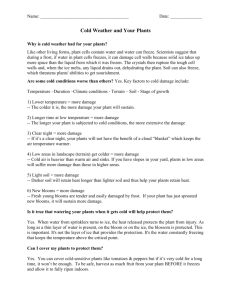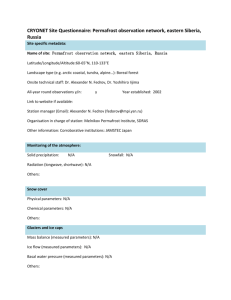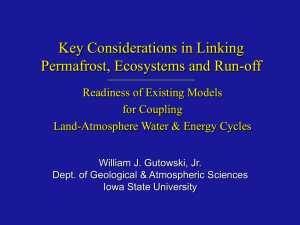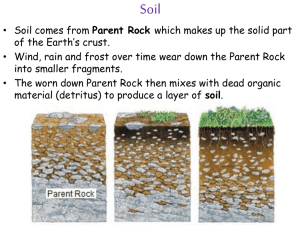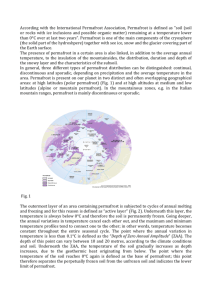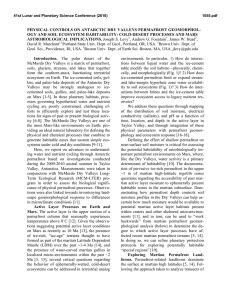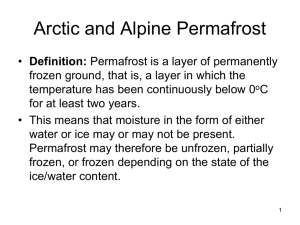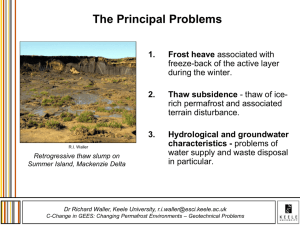Abstract Title - SWISS GEOSCIENCE MEETINGs
advertisement
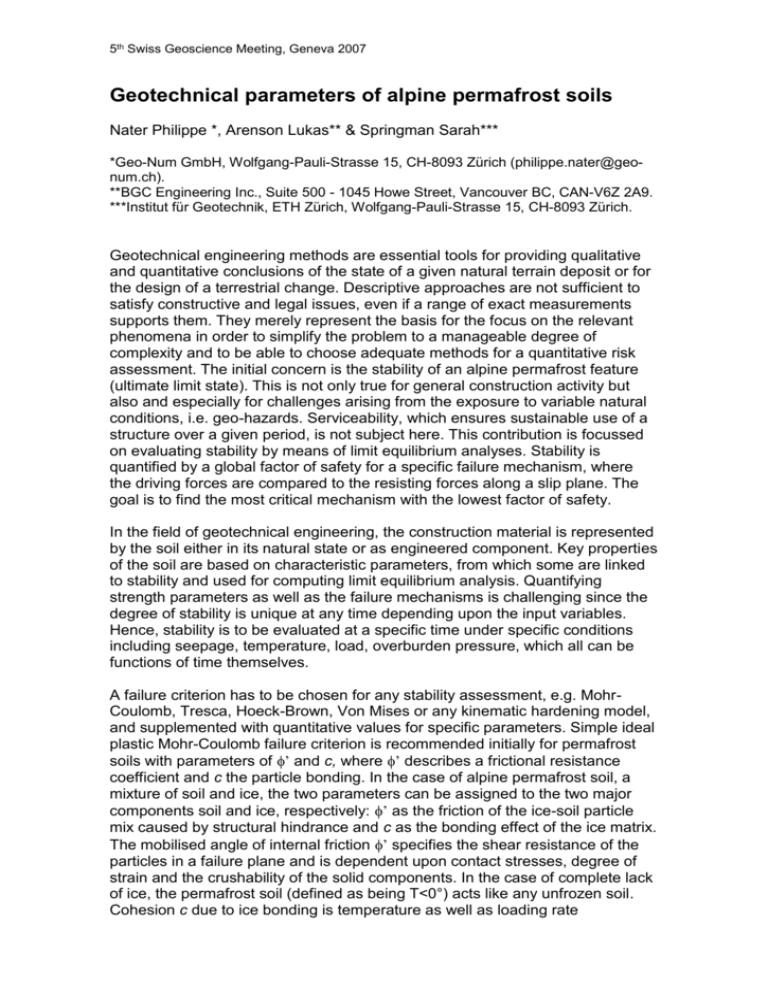
5th Swiss Geoscience Meeting, Geneva 2007 Geotechnical parameters of alpine permafrost soils Nater Philippe *, Arenson Lukas** & Springman Sarah*** *Geo-Num GmbH, Wolfgang-Pauli-Strasse 15, CH-8093 Zürich (philippe.nater@geonum.ch). **BGC Engineering Inc., Suite 500 - 1045 Howe Street, Vancouver BC, CAN-V6Z 2A9. ***Institut für Geotechnik, ETH Zürich, Wolfgang-Pauli-Strasse 15, CH-8093 Zürich. Geotechnical engineering methods are essential tools for providing qualitative and quantitative conclusions of the state of a given natural terrain deposit or for the design of a terrestrial change. Descriptive approaches are not sufficient to satisfy constructive and legal issues, even if a range of exact measurements supports them. They merely represent the basis for the focus on the relevant phenomena in order to simplify the problem to a manageable degree of complexity and to be able to choose adequate methods for a quantitative risk assessment. The initial concern is the stability of an alpine permafrost feature (ultimate limit state). This is not only true for general construction activity but also and especially for challenges arising from the exposure to variable natural conditions, i.e. geo-hazards. Serviceability, which ensures sustainable use of a structure over a given period, is not subject here. This contribution is focussed on evaluating stability by means of limit equilibrium analyses. Stability is quantified by a global factor of safety for a specific failure mechanism, where the driving forces are compared to the resisting forces along a slip plane. The goal is to find the most critical mechanism with the lowest factor of safety. In the field of geotechnical engineering, the construction material is represented by the soil either in its natural state or as engineered component. Key properties of the soil are based on characteristic parameters, from which some are linked to stability and used for computing limit equilibrium analysis. Quantifying strength parameters as well as the failure mechanisms is challenging since the degree of stability is unique at any time depending upon the input variables. Hence, stability is to be evaluated at a specific time under specific conditions including seepage, temperature, load, overburden pressure, which all can be functions of time themselves. A failure criterion has to be chosen for any stability assessment, e.g. MohrCoulomb, Tresca, Hoeck-Brown, Von Mises or any kinematic hardening model, and supplemented with quantitative values for specific parameters. Simple ideal plastic Mohr-Coulomb failure criterion is recommended initially for permafrost soils with parameters of ’ and c, where ’ describes a frictional resistance coefficient and c the particle bonding. In the case of alpine permafrost soil, a mixture of soil and ice, the two parameters can be assigned to the two major components soil and ice, respectively: ’ as the friction of the ice-soil particle mix caused by structural hindrance and c as the bonding effect of the ice matrix. The mobilised angle of internal friction ’ specifies the shear resistance of the particles in a failure plane and is dependent upon contact stresses, degree of strain and the crushability of the solid components. In the case of complete lack of ice, the permafrost soil (defined as being T<0°) acts like any unfrozen soil. Cohesion c due to ice bonding is temperature as well as loading rate 5th Swiss Geoscience Meeting, Geneva 2007 dependent. When the grains have no contacts, the shear strength in a failure plane is only due to the cohesion in the ice matrix; no frictional component can be mobilised. It is not given a priori that either ’ or c will be the major contribution towards the global stability of a slope. The combination is strongly dependent upon specific site conditions. Therefore, it is important to choose realistic values for both parameters, including consideration of the variability. The parameters ’ and c can be quantified according to laboratory tests on frozen soils although this is limited to relatively small particular sites. An empirical, non-linear correlation was adapted to assign the influence of the ice content and the temperature to these parameters for specific conditions. The general shear resistance of a failure plane in a permafrost soil can now be described as a combination of a frictional and a cohesive component where the input values are quantified according to their localisation in terms of ice content and temperature profile within a slope. Creep has no primary influence on the slope stability as long as the rate is not increasing in a logarithmic time scale. It may have significant impact on adjacent structures by causing large deformations or additional load. In addition, the strength parameters in the shear zone may change and decrease to residual values (e.g. ’res, cres) because of the large creep deformations. In consequence, it is not only important to quantify the surface velocity to identify creep as a phenomenon but also to determine the creep horizon and identify geotechnical characteristics at the appropriate depths for the stability assessment in a creeping zone. The dilation angle describes the interlocking and crushability between granular particles as a function of their packing and overburden stress, which is manifested as a variation of the internal friction angle ’and an increase in volume. In a dense granular material with low confining pressure, as observed in active layers, significant dilation can be mobilised before the angle of internal friction ’ decreases to the critical angle ’crit with ongoing shear deformation. However, as long as it is not known how much deformation has occurred and accumulated over time, choosing the maximum angle of internal friction ’peak, i.e. accounting for full dilation, is a speculative approach to evaluate the stability of a slope containing any material (not only frozen soils). In addition, the influence of dilation decreases as the confining pressure increases. In order to assess the stability of an existing or engineered alpine permafrost slope, it is crucial that the basic geotechnical behaviour of that particular soil is well known. Even though it is recommended that a simple model is used for ultimate limit state analysis, the input parameters have to be chosen carefully not only considering the change in the parameters with time, i.e. climate change scenarios, but also including factors such as seepage, unfrozen water or natural convection. These effects have a tremendous impact on the soil parameters and therefore efforts should concentrate on a proper determination of the crucial parameters to be used in a simple model rather than using a complex model with poorly defined input.
